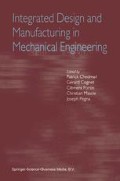Abstract
Variational assembly analysis is generally a complex problem. In this paper, a method to calculate the virtual and the resultant part for assembly is presented. These two parts represent an extension of the maximum and minimum material part theory previously proposed by Robinson [13]. They may be used during the analysis of the mechanical assembly in order to reduce complexity of the analysis. For a given part, the virtual and the resultant parts are not unique. Ts paper describes the method of calculation of a virtual and a resultant part. This method takes into account datum chaining between toleranced features. A kinematic model is used.
Access this chapter
Tax calculation will be finalised at checkout
Purchases are for personal use only
Preview
Unable to display preview. Download preview PDF.
References
ASME, ASME Y 14.5.1 M-1994. (1994). Mathematical definition of dimensioning and tolerancing principle. American society of mechanical engineers..
Ballot E. et Bourdet P. (1995). Equations formelles et tridimensionnelles des chaînes de dimensions in Les mécanismes. Séminaire tolérancement et chaîne de cotes, ENS de Cachan. 135–146.
Bennis F., Pino L. et Fortin C. (1998). Geometric tolerance transfer for manufacturing by an algebraic method. Proceedings of the 2nd International Conference on Integrated Design and Manufacturing in Mechanical Engineering, Compiègne, France. 713–720.
Bennis F., Pino L. et Fortin C. (1999). Analysis of positional tolerance based on the assembly virtual state. Proceeding of the 6th CIRP Seminar on Computer-Aided Tolerancing, University of Twente, The Netherlands. 415–424.
Latombe J.C., Wilson R.H. and Cazals F. (1997). Assembly sequencing with toleranced parts. Computer Aided Design, vol. 29:2, pp. 159–174, February 1997.
Pairel E. (1997). Métrologie par calibre virtuel sur machine à mesurer tridimensionnelle. PRIMECA. 5ème Colloque sur la Conception Mécanique Intégrée, 155–161.
Parratt S. W., (1994). A theoty of one-dimensional tolerancing for assembly. Thesis of Cornell University. May.
Pino L., Bennis F. et Fortin C. (1999). The use of a kinematic model to analyze positional tolerances in assemblies. Proceeding of the 1999 IEEE Conference on Robotics and Automation, Detroit, Michigan 1418–1423.
Requicha A. A. G. (1983). Toward a theoty of Geometric Tolerancing. The International Journal of Robotics Research, 2(4):45–60.
Requicha A. A. G. et Whalen T. W. (1992). Representation for assemblies. Institute for robotics and intelligent systems. Report n°267.
Rivest L., (1994). Modélisation et analyse tridimensionnelles des tolérances dimensionnelles et géométriques. Phd Thesis de l’Université de Montréal, Ecole Polytechnique.
Rivest L., Fortin C. et Morel C. (1994). Tolerancing a solid model with a kinematic formulation. Computer-Aided Design 26(6), 465–476.
Robinson D. M. (1998). Geometric tolerancing for assembly. Thesis of Cornell University. May.
Srinivasan V. et Jayaraman R. (1989). Geometric tolerancing: II. Conditional tolerance. IBM Journal of Research an Development, 33(2): 105–124.
Srinivasan V. (1993). The Role of Sweeps in Tolerancing Semantics. Manufacturing Review, 6(4):275–281.
Author information
Authors and Affiliations
Editor information
Editors and Affiliations
Rights and permissions
Copyright information
© 2002 Springer Science+Business Media Dordrecht
About this paper
Cite this paper
Pino, L., Bennis, F., Fortin, C. (2002). Calculation of Virtual and Resultant Part for Variational Assembly Analysis. In: Chedmail, P., Cognet, G., Fortin, C., Mascle, C., Pegna, J. (eds) Integrated Design and Manufacturing in Mechanical Engineering. Springer, Dordrecht. https://doi.org/10.1007/978-94-015-9966-5_23
Download citation
DOI: https://doi.org/10.1007/978-94-015-9966-5_23
Publisher Name: Springer, Dordrecht
Print ISBN: 978-90-481-6157-7
Online ISBN: 978-94-015-9966-5
eBook Packages: Springer Book Archive

